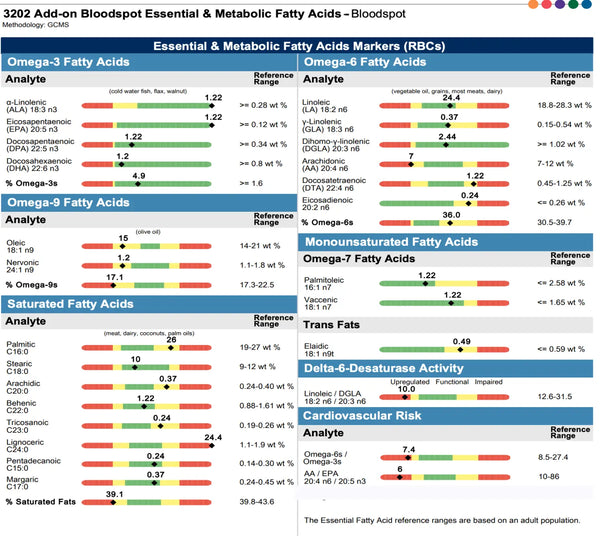Blood biomarkers are crucial in assessing an individual's overall health and longevity. While the significance of each biomarker can vary based on a person's age, gender, medical history, and overall health, there are 45 essential blood biomarkers that are commonly used as indicators of health and longevity based on current scientific knowledge.
It is important to note that while testing blood biomarkers is a good start, it is not the only way of measuring health and longevity. Other tests and markers that can provide a more comprehensive view of health and longevity include the organic acids test, which measures nutritional and metabolic biomarkers and the levels of amino acids in the urine and fatty acids in the blood. Additionally, quantifying the microbiota and microbiome can provide essential information on gut health and its impact on overall health.
Furthermore, a high-quality and comprehensive genetic test (DNA) can provide insights into an individual's genetic makeup and potential genetic predispositions to certain diseases. Also, an epigenetic test can provide information on how lifestyle and environmental factors affect gene expression and potential health outcomes. Thus, it is crucial to consider combining these tests and markers to gain a complete view of an individual's health and longevity.
Introduction
Physicians generally consider findings “normal” if they fall within the reference range. Often they miss the big picture by ignoring various markers. A test result within the reference range is considered “normal.” However, Medical Laboratory Science places the word in quotation marks as there isn’t a clear-cut line between what is normal and what is not. This is why the term “reference range” is used instead of “normal range”.

A lab result may be slightly higher or lower than the reference range without indicating that the individual is ill. This is problematic from the viewpoint of maintaining good health and preventing illness. The above interpretation is undoubtedly correct if health is viewed simply as the absence of disease. However, if health is considered vibrant and good at the population and individual level, the reference range may be viewed differently.
WHO (World Health Organization) took a stance on this topic in a statement from 2014; their latest comprehensive report published in the International Journal of Epidemiology in 2016 stated,” health is not just the absence of disease...”. The international understanding of this has increased recently, and preventive health care is becoming an equally important area compared to the medical care of illness.
What is an optimal level?
All laboratory markers certainly don’t have so-called optimal values determined in scientific studies, but such values do exist in some cases. Optimal values are likely to be based on findings made on a population level regarding low mortality or, for instance, the greatest likelihood of preventing cardiovascular disease associated with a particular marker. Optimal levels, as opposed to a reference range, have also been defined for some vitamins. For example, a testosterone level at the lower end of the reference range may indicate subclinical hypogonadism.
However, it is crucial always to compare the results to your previous results and track the changes over time, particularly after lifestyle changes. It is also beneficial to take several samples to get a bigger picture of various levels and to minimize the slight day-to-day variation before interpreting the results.
The 45 Most Important Blood Biomarkers
There are numerous blood biomarkers that are important for health and longevity, and their significance may vary depending on a person’s age, gender, medical history, and overall health. However, based on current scientific knowledge, here is a list of 45 blood biomarkers, ranked in no particular order, that are commonly used as indicators of health and longevity.
It is important to note that biomarkers should not be interpreted in isolation and should always be considered in the context of an individual’s medical history, lifestyle factors, and other relevant health metrics (all the references for the markers and more are found in the Optimize Your Lab Results Online Course).
- C-reactive protein (CRP): CRP is a protein that increases in response to inflammation in the body. High levels of CRP have been linked to an increased risk of heart disease, diabetes, and other chronic health conditions and mortality. Monitoring CRP levels can help identify inflammation and other related health issues.
- Fasting blood glucose: Fasting blood glucose is a measure of the amount of glucose in the blood after an overnight fast. Elevated blood glucose levels are a key indicator of diabetes and metabolic syndrome, which are associated with an increased risk of heart disease, stroke, and other chronic health conditions.
- Hemoglobin A1C (HbA1C): HbA1C measures average blood glucose levels over the past 2-3 months. High HbA1C levels indicate poor glucose control and insulin resistance and have been associated with an increased risk of heart disease, stroke, and other chronic health conditions.
- High-density lipoprotein (HDL) cholesterol: HDL cholesterol is often referred to as “good” cholesterol because it helps remove LDL cholesterol, or “bad” cholesterol, from the bloodstream. Low HDL levels are a risk factor for heart disease, while high levels are associated with a lower risk of heart disease and other chronic health conditions.
- Low-density lipoprotein (LDL) cholesterol: LDL cholesterol is often referred to as “bad” cholesterol because it can contribute to plaque formation in the arteries. High LDL levels may be a risk factor for heart disease and other chronic health conditions.
- Triglycerides: Triglycerides are a type of fat found in the blood. High triglyceride levels have been associated with an increased risk of heart disease, stroke, and other chronic health conditions.
- Total cholesterol: Total cholesterol is the sum of HDL, LDL, and other cholesterol particles in the blood. High total cholesterol levels are a risk factor for heart disease and other chronic health conditions. Then again, low total cholesterol may cause vitamin D deficiency, steroid hormone production problems, depression, and an increased risk of premature death from various causes.
- Homocysteine: Homocysteine is an amino acid that can be toxic to the body at high levels. Elevated homocysteine levels have been linked to an increased risk of heart disease and other chronic health conditions due to increased oxidative stress.
- Vitamin D: Vitamin D is an essential nutrient that plays a crucial role in bone health, immune function, and many other physiological processes. Low vitamin D levels have been linked to an increased risk of various health conditions, including osteoporosis, cancer, and autoimmune diseases.
- Serum iron: Serum iron levels measure the amount of iron in the blood. Iron is an essential nutrient that plays a critical role in the formation of red blood cells. High serum iron levels have been linked to an increased risk of heart disease and mortality, while low levels can lead to anemia.
- Ferritin: Ferritin is a protein that stores iron in the body. Elevated ferritin levels indicate excess iron storage, which has been linked to an increased risk of various health conditions, including heart disease, cancer, and diabetes. Too low levels indicate iron deficiency.
- Transferrin saturation: Transferrin saturation measures the amount of iron bound to transferrin, a protein that transports iron in the blood. Elevated transferrin saturation levels can indicate excess iron storage and an increased risk of various health conditions. Too low levels indicate iron deficiency.
- Complete blood count (CBC): A CBC measures several components of the blood, including red blood cells, white blood cells, and platelets. It can help diagnose and monitor various conditions such as anemia, infection, and leukemia.
- White blood cell count (WBC): A WBC count measures the number of white blood cells in the blood. It can help diagnose and monitor infections, inflammation, and immune system disorders. Lower but within the reference range levels are linked to reduced mortality risk.
- Red blood cell count (RBC): An RBC count measures the number of red blood cells in the blood. It can help diagnose and monitor anemia, kidney disease, and bone marrow disorders.
- Hemoglobin: Hemoglobin is a protein in red blood cells that carries oxygen throughout the body. A hemoglobin test measures the amount in the blood and can help diagnose and monitor anemia and other blood disorders.
- Hematocrit: Hematocrit measures the proportion of red blood cells in the blood. A hematocrit test can help diagnose and monitor anemia and dehydration.
- Mean corpuscular volume (MCV): MCV measures the average size of red blood cells. An MCV test can help diagnose and monitor anemia and other blood disorders.
- Mean corpuscular hemoglobin (MCH): MCH measures the amount of hemoglobin in a single red blood cell. An MCH test can help diagnose and monitor anemia and other blood disorders.
- Mean corpuscular hemoglobin concentration (MCHC): MCHC measures hemoglobin concentration in a given volume of red blood cells. An MCHC test can help diagnose and monitor anemia and other blood disorders.
- Platelet count: A platelet count measures the number of platelets in the blood. It can help diagnose and monitor bleeding, clotting, and bone marrow disorders. Lower but within the reference range levels are linked to reduced mortality risk.
- Fibrinogen: Fibrinogen is a protein produced in the liver involved in blood clotting. High fibrinogen levels in the blood can increase the risk of cardiovascular disease and stroke.
- D-dimer: D-dimer is a protein fragment produced when a blood clot is broken down. Elevated D-dimer levels in the blood can indicate a blood clot or thrombotic disorder.
- Prostate-specific antigen (PSA): PSA is a protein produced by the prostate gland in men. Elevated levels of PSA in the blood can be a sign of prostate cancer or other prostate-related conditions.
- Testosterone: Testosterone is a male sex hormone produced in the testes. Low testosterone levels can cause various symptoms in men, including fatigue, decreased libido, and muscle weakness. Read the comprehensive article on naturally elevating testosterone levels here.
- Estrogen: Estrogen is a female sex hormone produced in the ovaries. Low estrogen levels can cause various symptoms in women, including hot flashes, night sweats, and vaginal dryness. Learn more about estrogen and other female hormones in the Biohacking Women Online Course.
- Follicle-stimulating hormone (FSH): FSH is a hormone produced by the pituitary gland that stimulates the growth of ovarian follicles in women and the production of sperm in men. Elevated levels of FSH can be a sign of menopause in women or testicular failure in men.
- Luteinizing hormone (LH): LH is a hormone produced by the pituitary gland that stimulates ovulation in women and testosterone production in men. Elevated levels of LH can be a sign of menopause in women or testicular failure in men.
- Thyroid-stimulating hormone (TSH): TSH is a hormone produced by the pituitary gland that stimulates the thyroid gland to produce thyroid hormones. Elevated levels of TSH can be a sign of an underactive thyroid gland or hypothyroidism.
- Free triiodothyronine (fT3): fT3 is one of the two main thyroid hormones produced by the thyroid gland. Low levels of fT3 can be a sign of an underactive thyroid gland or hypothyroidism.
- Free thyroxine (fT4): fT4 is the other primary thyroid hormone produced by the thyroid gland. Low levels of fT4 can be a sign of an underactive thyroid gland or hypothyroidism.
- Thyroid peroxidase antibody (TPO): The antibody produced by the immune system can attack the thyroid gland and cause hypothyroidism. Elevated levels of TPO antibodies can be a sign of autoimmune thyroid disease.
- Adrenocorticotropic hormone (ACTH): ACTH is a hormone produced by the pituitary gland that stimulates the adrenal glands to produce cortisol, a steroid hormone. Elevated levels of ACTH can be a sign of adrenal insufficiency or Cushing’s syndrome.
- Cortisol: Cortisol is a steroid hormone produced by the adrenal glands in response to stress. It helps regulate the body’s response to stress and plays a role in blood sugar control, immune function, and inflammation. Abnormal levels of cortisol can be a sign of adrenal dysfunction or other health issues.
- Insulin-like growth factor 1 (IGF-1): IGF-1 is a hormone primarily produced by the liver in response to growth hormone. It is essential for normal growth and development; abnormal levels can be associated with growth disorders and other health issues. Low- and high-normal IGF-I levels are both related to insulin resistance.
- Dehydroepiandrosterone (DHEA): DHEA is a hormone produced by the adrenal glands and plays a role in producing sex hormones. Abnormal levels of DHEA can be associated with adrenal dysfunction and other health issues.
- Follicular phase estradiol: Estradiol is a type of estrogen hormone produced by the ovaries. During the follicular phase of the menstrual cycle, estradiol levels increase and play a role in preparing the body for ovulation. Abnormal estradiol levels can be associated with menstrual disorders and other health issues.
- Luteal phase progesterone: Progesterone is a hormone produced by the ovaries and is essential for preparing the uterus for pregnancy. During the luteal phase of the menstrual cycle, progesterone levels increase. Abnormal progesterone levels can be associated with menstrual disorders and other health issues.
- Cystatin C: Cystatin C is a protein produced by the cells in the body and is used to measure kidney function. Elevated levels of cystatin C can be a sign of reduced kidney function.
- Fasting insulin: Fasting insulin is a blood test that measures the amount of insulin in the blood after fasting. Insulin is a hormone produced by the pancreas that helps the body regulate blood sugar levels. High levels of fasting insulin can indicate insulin resistance or diabetes.
- Creatinine: Creatinine is a waste product generated by muscles during normal metabolism. It is filtered from the blood by the kidneys and excreted in the urine. A blood test that measures the level of creatinine in the blood can be used to evaluate kidney function. Elevated creatinine levels in the blood may indicate impaired kidney function or damage.
- Uric acid: Uric acid is a waste product produced when the body breaks down purines found in many foods and the body’s cells. The kidneys excrete most uric acid, but if too much uric acid is produced or the kidneys are not working correctly, uric acid levels in the blood can elevate. High uric acid levels in the blood can lead to gout, which causes joint pain and swelling. Elevated uric acid may also be a more crucial remediable risk factor for metabolic and cardiovascular diseases.
- Alanine aminotransferase (ALT): ALT is an enzyme found primarily in the liver. It is released into the bloodstream when liver cells are damaged, which can occur due to conditions such as hepatitis, alcohol abuse, or liver cancer. Elevated levels of ALT in the blood can indicate liver damage or disease. Moderate increases in ALT levels also occur with metabolic disorders such as hyperlipidemia, obesity, and type 2 diabetes.
- Aspartate aminotransferase (AST): AST is an enzyme found in many tissues in the body, including the liver, heart, and muscles. Like ALT, it is released into the bloodstream when cells are damaged. Elevated levels of AST can indicate damage to the liver, heart, or muscles.
- Gamma-glutamyl transferase (GGT): GGT is an enzyme found in the liver, pancreas, and other organs. It is involved in the metabolism of glutathione, an antioxidant that helps protect cells from damage. Elevated levels of GGT in the blood can indicate liver or bile duct disease and excessive alcohol consumption.
Most of these markers (95%) are covered in great detail in our most popular health-optimization learning platform; the Optimize Your Lab Results Online Course!
The Organic Acids Test (OAT)
The Organic Acids Test (OAT) is a diagnostic tool that measures organic acid metabolites in urine. These metabolites are produced by the body as a result of various metabolic pathways and can provide information on nutrient deficiencies, energy production, and the health of the gut microbiome.
The OAT can detect and monitor various conditions, including nutrient deficiencies, inflammation, oxidative stress, mitochondrial dysfunction, and abnormalities in neurotransmitter metabolism. It can also identify the overgrowth of harmful bacteria or yeast in the gut and imbalances in the gut microbiome that can contribute to a range of health issues.
One of the main benefits of the OAT is that it can provide a comprehensive view of an individual's metabolic profile, including information on how their body is processing various nutrients and how well their mitochondria are functioning. The OAT can help healthcare practitioners tailor nutritional and supplemental interventions to an individual's unique needs by identifying nutrient deficiencies and imbalances. Additionally, by identifying imbalances in the gut microbiome, the OAT can help guide dietary and lifestyle interventions that can improve gut health and overall health outcomes.
We recommend taking the Metabolomix+ home test.
Metabolic Areas of Metabolomix + Analysis:
Basic profile:
- Organic acids
- Absorption disorders and dysbiosis
- Cellular energy and mitochondria
- Mediators
- Vitamin tracers
- Toxin and detoxification markers
- Tyrosine metabolism
- Amino acids
- Essential amino acids
- Non-essential amino acids
- Intermediates of metabolism
- Markers for dietary peptides
- Markers of oxidative stress
See a complete Metabolomix+ sample report here.
Amino acids (urine)
Amino acids contain four essential elements: carbon (C), hydrogen (H), oxygen (O), and nitrogen (N). There are twenty amino acids that are important for humans, of which nine are essential (must be obtained from dietary sources), and the remaining eleven are synthesized in the body. Thus, amino acids are classified into essential and non-essential amino acids. Some of the dispensable amino acids are still classified as conditionally essential or conditionally indispensable, i.e., they must be received from dietary sources, as their synthesized amount cannot fully meet the body ́s needs.
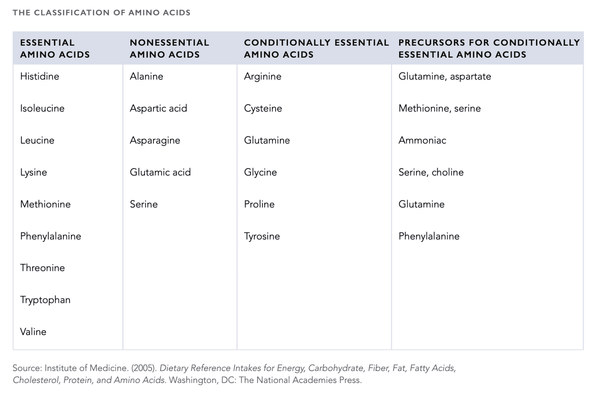
The body needs the proteins formed from amino acids to tackle several different tasks. They are as follows:
- Tissue growth and regeneration
- Repair of damaged tissue
- Detoxification
- Food digestion (digestive enzymes)
- Enzymes and cofactors (they catalyze chemical reactions in the body)
- Structural components (in tissues and cell membranes)
- Acceleration and regulation of chemical processes (coenzymes etc.)
- Acting as biological transfer proteins (e.g., hemoglobin)
- Maintaining immune system function (antibodies and immunoglobulins)
- Mediators and signal carriers
- Acting as a hormone
- Ferritin storage
- Energy production
- Cell movement
Fatty acids (blood)
Fatty acids are chemical compounds consisting of carbon, hydrogen, and the carboxyl group, which also contains oxygen. Fatty acids are monocarboxylic acids, which always have an even amount of carbon atoms. In nature, they form carbon chains of various lengths, which determine the class of fatty acids (short-chain fatty acids, medium-chain fatty acids, long-chain fatty acids, and very-long-chain fatty acids).
The body can synthesize short-chain fatty acids in the intestine with the help of intestinal bacteria. In addition, medium-chain fatty acids are also found in nature (e.g., in a coconut). The saturation degree of fatty acids depends on the possible double bonds between the carbon chains. Saturated fatty acids contain only single bonds. Monounsaturated fatty acids have one double bond between carbon atoms, and polyunsaturated fatty acids have several bonds. Hence, fatty acids can be either saturated, monounsaturated, or polyunsaturated.
Fatty acids affect cell signaling in the body and alter gene expression in fat and carbohydrate metabolism. Moreover, fatty acids may act as ligands for the peroxisome proliferation-activated receptors (PPARs), which play an essential role in the regulation of inflammation (i.e., eicosanoids), fat formation (adipogenesis), insulin, and neurological functions, among others.
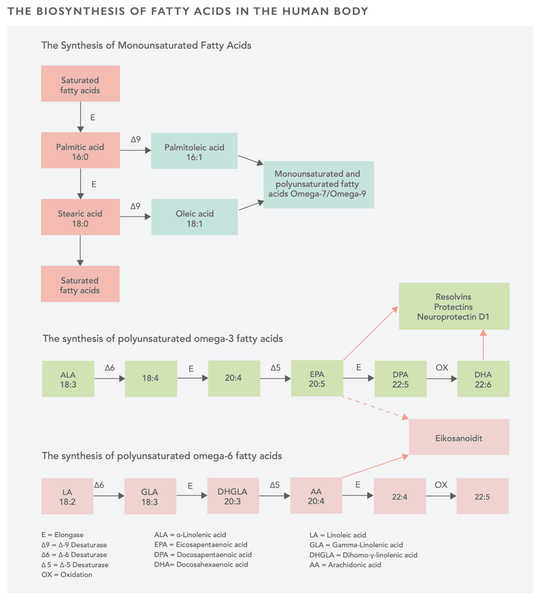
Fatty acids add-on for Metabolomix+
This add-on can be added to the Metabolomix+ test, and it covers Essential and Metabolic Fatty Acids with an easy at-home bloodspot finger prick.
Analytes covered in this add-on:
- Omega 3 Fatty Acids are essential for brain function and cardiovascular health and are anti-inflammatory
- Omega 6 Fatty Acids are involved in the balance of inflammation
- Omega 9 Fatty Acids are essential for brain growth, nerve cell myelin, and reducing inflammation
- Saturated Fatty Acids are involved in lipoprotein metabolism and adipose tissue inflammation
- Monounsaturated Fats include omega-7 fats and unhealthy trans fats
- Delta-6 Desaturase Activity assesses the efficiency of this enzyme to metabolize omega 6’s and omega 3’s
- Cardiovascular Risk includes specific ratios and the Omega-3 Index
Gut microbiome & microbiota – a key test for everyone
Microbiome and microbiota are sometimes interchangeable, but these terms differ. The microbiome is the collection of genomes from all the microorganisms in the environment. For example, the human microbiome refers to a group of microorganisms around the body (including skin, eyes, gut, and so on). Microbiota usually refers to specific microorganisms that are found within a particular environment. In this case, microbiota (i.e., gut microbiota) refers to all microorganisms found in the gut, such as bacteria, viruses and fungi.
It is estimated that 500–1,000 distinct bacterial species live in the intestine. The most common bacterial species in the intestine are Bacteroides, Clostridium, Fusobacterium and Bifidobacterium. Other known strains include Escherichia and Lactobacillus. The Bifidobacterium and Lactobacillus strains are typically present in probiotic products because these are the most widely studied.
The functions of the bacteria in the intestines include breaking down carbohydrates (fermentation) that the body cannot otherwise digest. The intestines' bacterial strains also play a role in the absorption of K vitamins, B vitamins, and some minerals (magnesium, calcium, and iron) in the production of bile acids and the immune system. In addition, they act as protective walls against various pathogens.
The bacterial strain of the intestine changes quickly whenever dietary adjustments are made. Studies on mice have found that the microbiota may change overnight upon changing the diet. Similar changes also occur in humans, but the exact time span is unknown. Switching to a more intestine-friendly diet has brought positive results in the treatment of chronic inflammation, obesity, and gut permeability.
GI360 – The Lamborghini of Gut Tests
A personal treatment strategy is the future of medicine. It is based on data related to individual biochemistry and genetic inheritance. This test will help you gain objective information about yourself, create a more accurate treatment strategy, and implement changes that will lead to better health.
The GI360 x3 intestinal assay uses several screening methods (multiplex PCR, MALDI-TOF, and microscopy) to detect pathogens, viruses, parasites, and bacteria. These may manifest as acute or chronic gastrointestinal symptoms and diseases or possibly as intestinal-related symptoms.
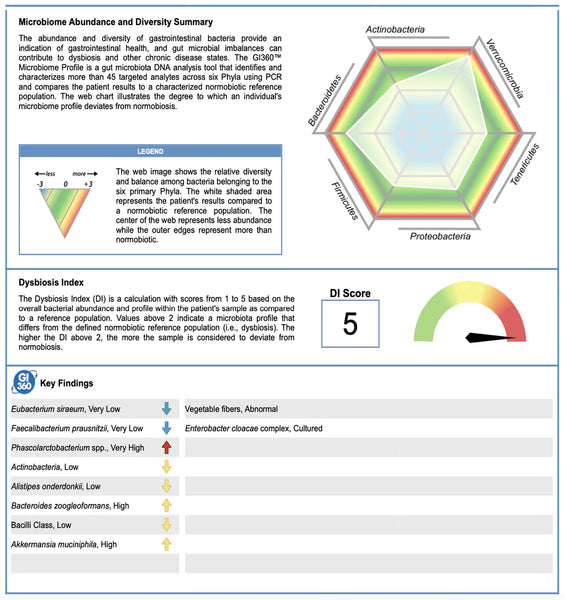
Image: Sample report first page analysis of the GI 360 test.
Microbiome Abundance and Diversity
The GI360™ Profile is a gut microbiota DNA analysis tool that identifies and characterizes the abundance and diversity of more than 45 targeted analytes that peer-reviewed research has shown to contribute to dysbiosis and other chronic disease states.
The Dysbiosis Index (DI) is a calculation with scores from 1 to 5 based on the overall bacterial abundance and Profile within the patient's sample compared to a reference population. Values above 2 indicate a microbiota profile that differs from the defined normobiotic reference population (i.e., dysbiosis). The higher the DI above 2, the more the sample is considered to deviate from normobiosis.
Among other things, this information can be used to consider and build an individualized treatment program.
The test is particularly suitable for use in the following intestinal diseases and chronic problems:
- Gastrointestinal symptoms
- Autoimmune diseases
- IBD / IBS
- Inflammations
- Food hypersensitivity
- Nutritional deficiencies
- Joint pain
- Chronic or acute diarrhea
- Bloody stools
- Mucosal dysfunction
- Stomach ache
- Fever and vomiting
The extensive GI360 x3 gut analysis is currently the most accurate and comprehensive analysis of the total balance of the gastrointestinal system. Numerous functional medicine physicians around the world also use the test.
Genetic Testing (DNA) and Its Vast Possibilities
Knowing your genetic code is made possible by new DNA tests based on the latest science and technology. They can help make better choices in everyday life and find more effective ways to change lifestyles. At the same time, DNA tests help optimize health and achieve personal goals.
Genetic testing is a powerful tool that has revolutionized the field of healthcare. It allows individuals to gain insight into their genetic makeup and better understand their risk of developing certain diseases or conditions. By analyzing an individual's DNA, genetic testing can reveal information about genetic mutations, variations, and changes that can significantly impact an individual's health. With this information, individuals can make more informed decisions about their health, including lifestyle changes and preventive measures, to reduce their risk of developing certain conditions.
Furthermore, genetic testing can diagnose and treat various diseases, providing personalized and targeted treatments that can significantly improve patient outcomes. The importance of genetic testing in healthcare cannot be overstated, and as technology advances, it can potentially transform how we approach disease prevention and treatment.
Integral DNA: Combination Of Three DNA Tests (Resilience + Health + Active)
Precision nutrition, precision medicine, and nutrigenomics are all related concepts revolutionizing how we think about health and nutrition. At their core, these terms refer to using advanced technology and data to create personalized health plans. Understanding the individual's DNA and lifestyle can tailor these plans to meet a person's unique needs.
With Integral DNA, you'll get three powerful new genetic tests to help you make better life choices and more effective lifestyle changes. By knowing your genetic code, you can unlock the secrets of your body to optimize health and reach personal goals.
The test kit consists of three different genetic tests, giving you a comprehensive picture of your health. Previously, for the price of one genetic test, you get three.
DNA Health
DNA Health® tests known genetic variants that significantly impact health and various risks of diseases such as osteoporosis, cancer, cardiovascular diseases and diabetes.
DNA Active
DNA Active analyzes genes that have been found to significantly affect the following areas: soft tissue injury risk, recovery, power generation potential, endurance potential, caffeine metabolism, salt sensitivity, and timing of peak performance.
DNA Resilience
DNA Resilience provides information on seven key molecular regions that impact stress and resilience the most. These include neuropeptide Y, oxytocin, neurotrophic factors, cortisol, norepinephrine, dopamine and serotonin.
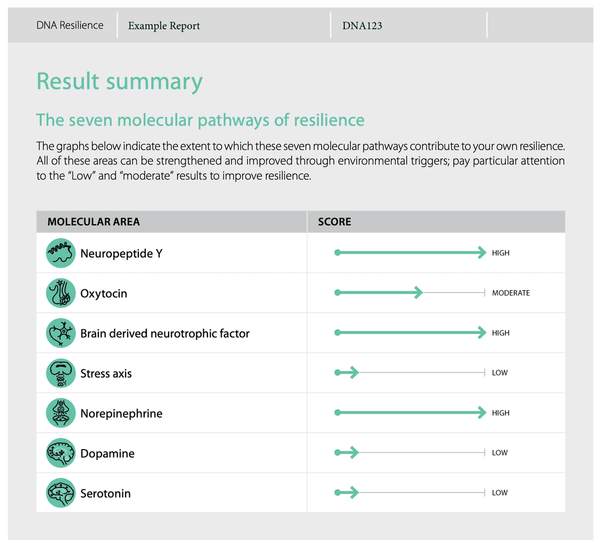
Image: Example summary of the DNA Resilience test.
Learn more about the Integral DNA Test here.
Epigenetic Testing - The Future of Preventive Medicine?
Epigenetics studies how gene expression changes can occur without changes in the underlying DNA sequence. Various factors, including environmental exposures, lifestyle choices, and other external influences, can influence this.
In terms of human health, epigenetics is thought to play a role in various conditions, including cancer, cardiovascular disease, and neurological disorders. By better understanding the underlying mechanisms of epigenetic changes, researchers hope to develop new therapies and interventions that can prevent or treat these conditions.
Some factors that have been shown to influence epigenetic changes include diet, exercise, stress, and exposure to toxins and pollutants. Genetic factors can also play a role in determining an individual's susceptibility to epigenetic changes.
While much is still unknown about the complex interplay between genetics, epigenetics, and environmental factors, research in this field is advancing rapidly. It has the potential to revolutionize our understanding of human health and disease.
The epigenome is a dynamic system that plays a significant role in aging. DNA methylation and histone modifications change with chronological age and chronic diseases. Aging is associated with general hypomethylation and local hypermethylation. To appropriately analyze DNA methylation, various "epigenetic clocks" have been developed (such as the Horvath clock, Weidner Clock, and Hannum clock).
Types of Epigenetic Modifications
Several different epigenetic modifications can be measured, each of which can provide important insights into an individual's health and disease risk. These include:
- DNA methylation: This is adding a methyl group to a specific location on the DNA molecule, which can alter how genes are expressed. Abnormal methylation patterns have been associated with various diseases, including cancer and cardiovascular disease.
- Histone modification: Histones are proteins that help to package DNA into a compact structure. Modification of histones can change the accessibility of genes, either promoting or inhibiting their expression.
- Non-coding RNA: Non-coding RNA molecules do not code for proteins but can regulate gene expression by interacting with other RNA molecules or proteins.
- Chromatin structure: The way that DNA is packaged into chromatin can also affect gene expression, and changes in chromatin structure have been linked to various diseases.
Aging is an extraordinarily complex and highly individual process that needs to be fully understood. Therefore many biomarkers related to aging may only scratch the surface and give a point of view from a specific angle on what comes to aging. Hence, a combination of wide-ranging routine laboratory tests, epigenetic tests, molecular biomarkers, and phenotypic markers may be the best solution to evaluate a comprehensive view of an individual aging process.
Biohacker Center will provide the most cutting-edge epigenetic tests available in the future.
For now, we recommend taking the GlycanAge test, which is an at-home blood test that analyses glycans (sugars that coat cells) in the body to determine your biological age. They look at your IgG glycome composition (which regulates low-grade chronic inflammation and drives aging). GlycanAge technology goes beyond existing biological age tests by integrating genetic, epigenetic, and environmental aspects of aging.
With increasing emphasis on preventative health and a growing desire to personalize and validate health interventions. GlycanAge is the most sensible place to track lifestyle changes as it provides an independent measure of health.
Learn more about GlycanAge test here.
Conclusion
For a complete assessment of your overall health, utilizing the biomarkers mentioned in this article and relying on current scientific knowledge of human physiology is highly recommended. It's advisable to take all these tests at least once and follow up with a test after making lifestyle changes in 6-12 months to evaluate their impact on your physiology, biochemistry, and epigenetics.
To obtain a holistic view of your health, we suggest undergoing a comprehensive blood biomarkers panel, organic acids test, amino acids (which are included in the organic acids test), fatty acids (as an add-on to the organic acids test), comprehensive microbiota test, integral DNA test and an epigenetic test. These tests are designed to give you a more accurate and in-depth understanding of your health. With the follow-up test after making lifestyle changes, you'll be able to monitor your progress and make more informed decisions about your health.








